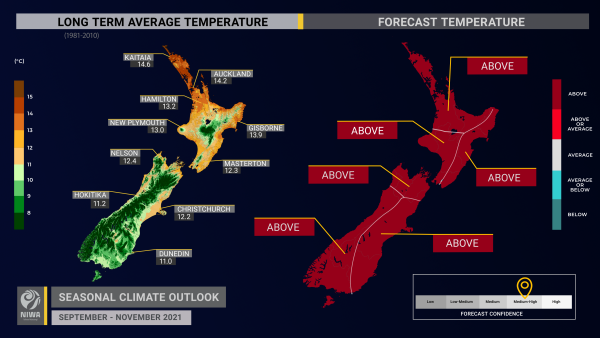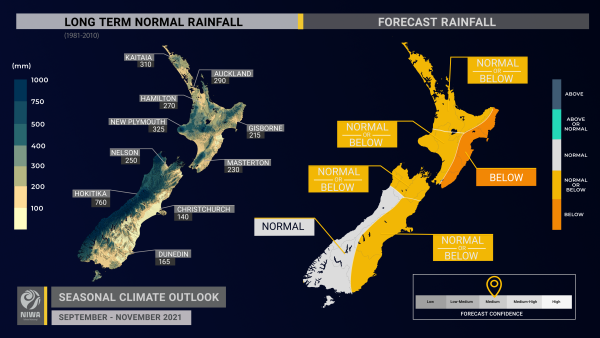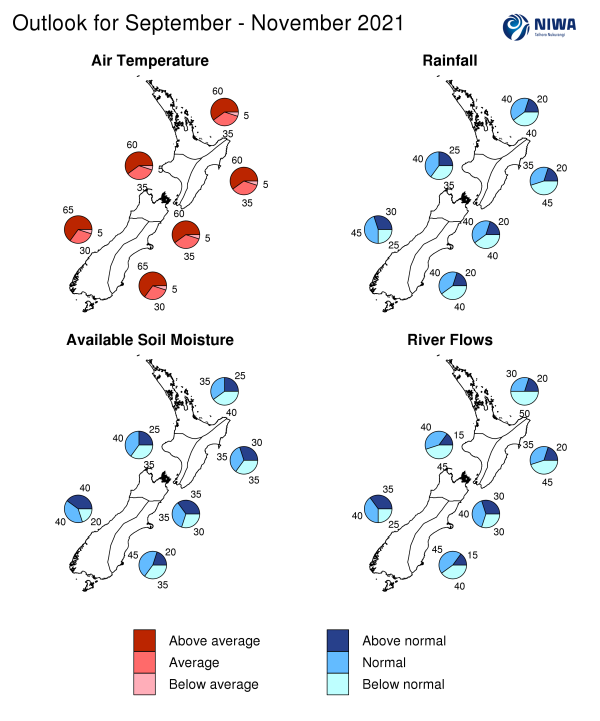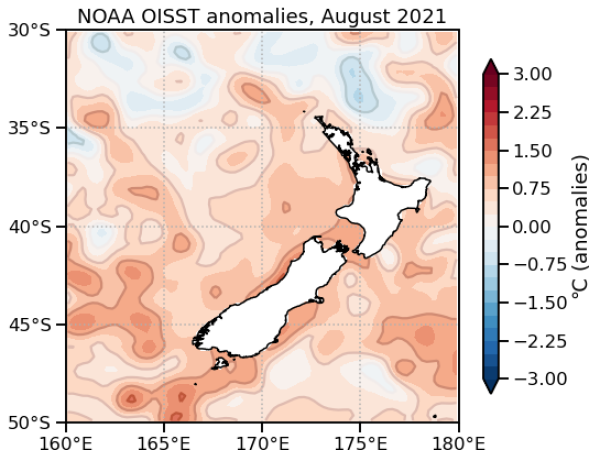Outlook Summary
- Spring rainfall is most likely to be below normal in the east of the North Island, near normal in the west of the South Island, and about equally likely to be near normal or below normal in all remaining regions across Aotearoa New Zealand.
- The trend of warmer than average temperatures is very likely to continue during spring. Unseasonably warm conditions will occur at times, particularly in the east of both islands. Despite this, cold spells and frosts can still occur occasionally, especially early in the season.
- Air pressure is expected to be higher than normal over and to the east of New Zealand. Frequent high pressure systems may contribute to lengthy dry spells for the time of year.
- New Zealand’s coastal sea surface temperatures (SSTs) ranged from 0.6˚C to 1.1˚C above average during August and are predicted to become more unusually warm by November.
- NIWA continues in La Niña Watch, acknowledging ocean and atmosphere conditions in the Pacific Ocean are trending toward La Niña for the 2nd consecutive year. For more information, see the Background.
- Soil moisture levels are about equally likely to be near normal or below normal in the north and west of the North Island, most likely to be near normal in the east of the South Island, and about equally likely to be near normal or above normal in the west of the South Island. No clear guidance was available for the east of the North Island and north of the South Island.
- River flows are most likely to be below normal in the north and east of the North Island, about equally likely to be below normal or near normal in the west of the North Island and east of the South Island, most likely to be near normal in the north of the South Island, and about equally likely to be near normal or above normal in the west of the South Island.
Regional predictions for September – November 2021
Northland, Auckland, Waikato, Bay of Plenty
The table below shows the probabilities (or percent chances) for each of three categories: above average, near average, and below average. In the absence of any forecast guidance there would be an equal likelihood (33% chance) of the outcome being in any one of the three categories. Forecast information from local and global guidance models is used to indicate the deviation from equal chance expected for the coming three-month period, with the following outcomes the most likely (but not certain) for this region:
- Temperatures are very likely to be above average (60% chance).
- Rainfall totals are equally likely to be near normal (40% chance) or below normal (40% chance).
- Extended dry spells, unusual for the time of year, are likely.
- Soil moisture levels are about equally likely to be below normal (40% chance) or near normal (35% chance) while river flows are most likely to be below normal (50% chance).
The full probability breakdown is:
|
Temperature |
Rainfall |
Soil moisture |
River flows |
|
|
Above average |
60 |
20 |
25 |
20 |
|
Near average |
35 |
40 |
35 |
30 |
|
Below average |
05 |
40 |
40 |
50 |
Central North Island, Taranaki, Whanganui, Manawatu, Wellington
Probabilities are assigned in three categories: above average, near average, and below average.
- Temperatures are very likely to be above average (60% chance).
- Rainfall totals are about equally likely to be near normal (40% chance) or below normal (35% chance).
- Soil moisture and river flow levels are about equally likely to be near normal (40% chance) or below normal (35-45% chance).
The full probability breakdown is:
|
Temperature |
Rainfall |
Soil moisture |
River flows |
|
|
Above average |
60 |
25 |
25 |
15 |
|
Near average |
35 |
40 |
40 |
40 |
|
Below average |
05 |
35 |
35 |
45 |
Gisborne, Hawke’s Bay, Wairarapa
Probabilities are assigned in three categories: above average, near average, and below average.
- Temperatures are very likely to be above average (60% chance).
- Rainfall totals are most likely to be below normal (45% chance).
- Extended dry spells, unusual for the time of year, are likely.
- Soil moisture levels are below normal for the time of year across Hawke’s Bay.
- Periods of unseasonable warmth are possible due to more northwesterly winds.
- River flows are most likely to be below normal (45% chance). No clear guidance was available for soil moisture levels.
The full probability breakdown is:
|
Temperature |
Rainfall |
Soil moisture |
River flows |
|
|
Above average |
60 |
20 |
30 |
20 |
|
Near average |
35 |
35 |
35 |
35 |
|
Below average |
05 |
45 |
35 |
45 |
Tasman, Nelson, Marlborough, Buller
Probabilities are assigned in three categories: above average, near average, and below average.
- Temperatures are very likely to be above average (60% chance).
- Rainfall totals are equally likely to be near normal (40% chance) or below normal (40% chance).
- Extended dry spells, unusual for the time of year, are likely.
- River flows are most likely to be near normal (40% chance). No clear guidance was available for soil moisture levels.
The full probability breakdown is:
|
Temperature |
Rainfall |
Soil moisture |
River flows |
|
|
Above average |
60 |
20 |
35 |
30 |
|
Near average |
35 |
40 |
35 |
40 |
|
Below average |
05 |
40 |
30 |
30 |
West Coast, Alps and foothills, inland Otago, Southland
Probabilities are assigned in three categories: above average, near average, and below average.
- Temperatures are very likely to be above average (65% chance).
- Rainfall totals are most likely to near normal (45% chance).
- More westerly wind flows during September can bring frequent fronts to the region, elevating the potential for heavy rainfall.
- Soil moisture levels and river flows are about equally likely to be near normal (40% chance) or above normal (35-40% chance).
The full probability breakdown is:
|
Temperature |
Rainfall |
Soil moisture |
River flows |
|
|
Above average |
65 |
30 |
40 |
35 |
|
Near average |
30 |
45 |
40 |
40 |
|
Below average |
05 |
25 |
20 |
25 |
Coastal Canterbury, east Otago
Probabilities are assigned in three categories: above average, near average, and below average.
- Temperatures are very likely to be above average (65% chance).
- Rainfall totals are equally likely to be near normal (40% chance) or below normal (40% chance).
- Extended dry spells, unusual for the time of year, are likely.
- Soil moisture levels are currently near normal.
- Periods of unseasonable warmth are possible due to more northwesterly winds.
- Soil moisture levels are most likely to be near normal (45% chance) while river flows are about equally likely to be near normal (45% chance) or below normal (40% chance).
The full probability breakdown is:
|
Temperature |
Rainfall |
Soil moisture |
River flows |
|
|
Above average |
65 |
20 |
20 |
15 |
|
Near average |
30 |
40 |
45 |
45 |
|
Below average |
05 |
40 |
35 |
40 |
Graphical representation of the regional probabilities
Background
The NINO3.4 Index anomaly (in the central Pacific) during August (through the 29th) was -0.17˚C, although the latest weekly value had dropped to -0.26˚C. The Southern Oscillation Index was +0.4, in ENSO neutral territory.
During August, upper-oceanic heat content decreased across the equatorial Pacific for the third consecutive month. The cooling effect of an upwelling Kelvin wave continued during the month.
Cooler than average equatorial sub-surface waters (-0.5˚C to -1.5˚C) progressed toward the surface in the central Pacific while a layer of warmer than average seas persisted near the surface off the west coast of South America. The distribution of anomalies is currently closest to a central Pacific type of La Niña, similar to that of this time last year.
Trade winds were again enhanced in the equatorial central Pacific, which is where cooling of the sea surface was focused. Enhanced trade winds are expected to continue through the month of September, particularly in the central equatorial Pacific, which should result in additional cooling of the sea surface.
A negative Indian Ocean Dipole (IOD), referring to well above average SSTs in the tropical eastern Indian Ocean, continued during August. An Atlantic Niño, characterised by warmer than average ocean temperatures in the central and eastern equatorial Atlantic, also persisted. These teleconnections, or climate patterns related to one another across long distances, support an ocean-atmosphere system that is likely to continue to trend in a La Niña-like direction.
La Niña or ENSO “cool” neutral conditions are about equally likely (45-50% chance each) during spring before the chance for La Niña peaks at 50-60% during summer.
During August, convective forcing was focused over the Atlantic Ocean, Africa, and the Indian Ocean. A cell of suppressed convection was observed over the Pacific, strongest just west of the International Date Line.
During September, convective forcing is expected to favour the Indian Ocean and Maritime Continent before moving into the Pacific late in the month. This corresponds to Madden-Julian Oscillation (MJO) phases 2-5, which typically come with warmer than average temperatures and more rainfall in the western South Island (phases 2 and 4) and less rainfall in the north and east of the North Island (phases 2 and 3).
Looking ahead to October, the MJO could start the month in phase 7 or 8 before moving toward Africa and the Indian Ocean (phases 1-3). These phases have historically been associated with mixed rainfall and temperatures patterns in New Zealand. By November, forcing could become more prominent over the Maritime Continent and western Pacific should La Niña-like patterns continue to build.
The Southern Annular Mode (SAM) was variable during August. The SAM will likely feature additional variability during September, although it may spend more time in its positive phase during the expected spells of higher-than-normal pressure.
New Zealand’s coastal water temperature anomalies remained warmer than average during August, ranging from 0.6˚C to 1.1˚C above average. This will have an upward influence on air temperatures.
NZ coastal SST anomalies during August 2021 (through the 29th)
|
North NI |
0.60˚C |
|
West NI |
1.07˚C |
|
East NI |
0.63˚C |
|
North SI |
1.06˚C |
|
West SI |
0.98˚C |
|
East SI |
1.01˚C |
Forecast Confidence
Temperature
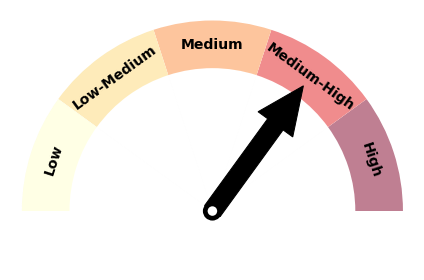
|
Forecast confidence for temperatures is medium to high. Sea surface temperatures remain warmer than average, which have been a good benchmark for on-land temperatures in recent months. Southerly wind flows are not favoured for the season, which should limit the number of cold outbreaks. |
Rainfall
|
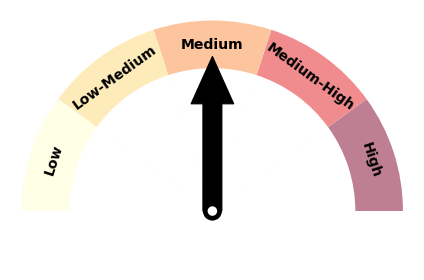
|
Forecast confidence for rainfall is medium. Periods of higher-than-normal pressure through the season will likely lead to extended dry spells, particularly in eastern areas. Models are in relatively good agreement on a drier-leaning season. La Niña-like conditions in the ocean and atmosphere should help with overall predictability.
|

